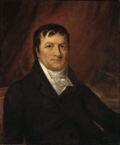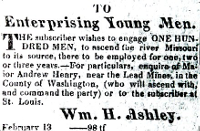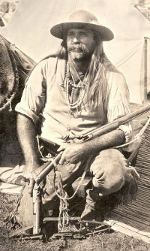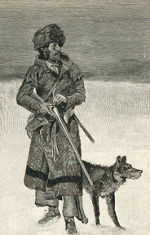The Fur Trade in North America
By the late 1700s, the fur trade was in decline in the eastern part of what is now the United States, mainly because the English settlers had cleared a large part of the available land for settlement. As the colonies and then states grew, residents looked more and more to the West–for new opportunities to live, to farm, and to work. The English/American fur trade experienced a strong revival after the Louisiana Purchase in 1803. One prominent addition to the fur trade came as traders moved west: the bison. Buffalo hides, as they became known, were in high demand in parts east for many years. 
In 1794, John Jacob Astor one of the fur trade's most successful businessmen, entered the picture. His most important contribution was the formation of the American Fur Company, in 1808, the major impetus of which was the return of the Lewis & Clark expedition from the west coast in 1806. Astor followed that three years later with the establishment of the South West Company. Astor and many other fur traders suffered when the War of 1812 began. After the war ended, in 1815, the U.S. announced a prohibition of foreign traders operating within American borders; as a result, the North West Company left its American operations. Another well-known trader in the early part of the 19th Century was Manuel Lisa, a Spanish-American trader who went into business with William Clark, Andrew Henry, and Jean Pierre Chouteau to form the St. Louis Missouri Fur Company The Hudson's Bay Company and the North West Company joined forces in 1821. Economic conflict with Astor's American Fur Company was common for more than a decade. 
In 1822, William Henry Ashley joined with Andrew Henry, who had been on expeditions through the West a decade earlier, to form the Rocky Mountain Fur Company. On Feb. 13, 1822, Ashley placed an ad in the Missouri Gazette & Public Advertiser, a St. Louis newspaper, that sought a number of adventuresome men to travel west to take part in the burgeoning fur trade. A similar ad appeared in the St. Louis Enquirer two weeks later. 
Ashley and Henry benefited from a great many applicants, who became known as "Ashley's Hundred." Some of those became America's most famous Mountain Men; among those were Jim Bridger (right), Hugh Glass, Jedediah Smith, and Thomas Fitzpatrick. To facilitate the transportation of furs back east, Ashley and Henry followed the earlier example of the North West Company and set up an annual Rendezvous, a sort of open-air market that operated at the end of the trapping season; in exchange for furs, trappers could receive supplies for the next season. As the French and English before them, American fur traders built networks of trading posts and they expanded the fur trade westward. Some of those trading posts became major cities, including Detroit, New Orleans, and St. Louis. The same had been true in Canada, for such cities as Edmonton, Montreal, and Winnipeg. Next page: The End of an Era > Page 1, 2, 3, 4 |
|
Social Studies for Kids
copyright 2002–2025
David White



 in 1809. Their target was the area around the upper Missouri River. They enjoyed some initial success and had some sustained success. However, a combination of Native American hostility and the outbreak of the War of 1812 convinced the owners to close up the company, in 1814. One significant thing that Lisa did was establish a trading post at the junction of the Bighorn River and the Yellowstone River; this became Fort Raymond, the first American trading post built in the Rocky Mountains. Lisa was an influential fur trader in that subsequent traders employed many of his methods in pursuing their trade.
in 1809. Their target was the area around the upper Missouri River. They enjoyed some initial success and had some sustained success. However, a combination of Native American hostility and the outbreak of the War of 1812 convinced the owners to close up the company, in 1814. One significant thing that Lisa did was establish a trading post at the junction of the Bighorn River and the Yellowstone River; this became Fort Raymond, the first American trading post built in the Rocky Mountains. Lisa was an influential fur trader in that subsequent traders employed many of his methods in pursuing their trade.
